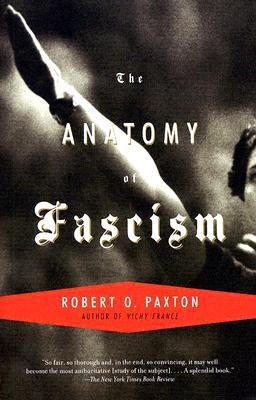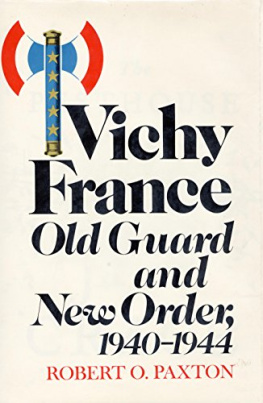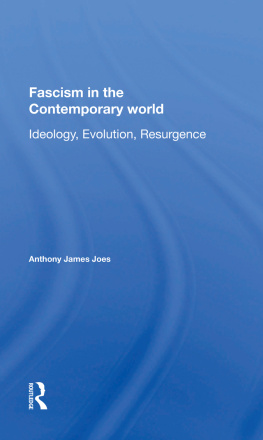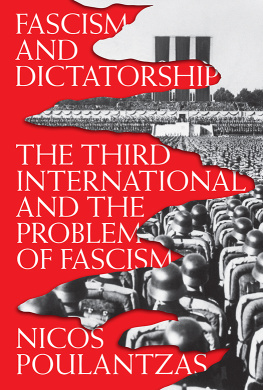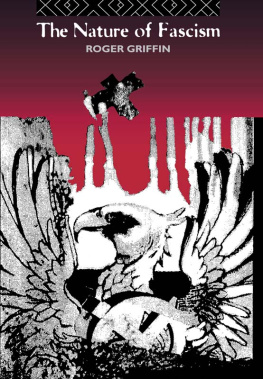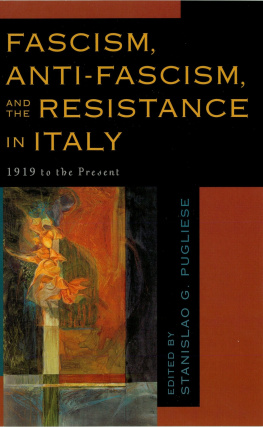Robert O. Paxton - What Is Fascism?: from The Anatomy of Fascism
Here you can read online Robert O. Paxton - What Is Fascism?: from The Anatomy of Fascism full text of the book (entire story) in english for free. Download pdf and epub, get meaning, cover and reviews about this ebook. year: 2018, publisher: Vintage, genre: Politics. Description of the work, (preface) as well as reviews are available. Best literature library LitArk.com created for fans of good reading and offers a wide selection of genres:
Romance novel
Science fiction
Adventure
Detective
Science
History
Home and family
Prose
Art
Politics
Computer
Non-fiction
Religion
Business
Children
Humor
Choose a favorite category and find really read worthwhile books. Enjoy immersion in the world of imagination, feel the emotions of the characters or learn something new for yourself, make an fascinating discovery.

- Book:What Is Fascism?: from The Anatomy of Fascism
- Author:
- Publisher:Vintage
- Genre:
- Year:2018
- Rating:3 / 5
- Favourites:Add to favourites
- Your mark:
- 60
- 1
- 2
- 3
- 4
- 5
What Is Fascism?: from The Anatomy of Fascism: summary, description and annotation
We offer to read an annotation, description, summary or preface (depends on what the author of the book "What Is Fascism?: from The Anatomy of Fascism" wrote himself). If you haven't found the necessary information about the book — write in the comments, we will try to find it.
What Is Fascism?: from The Anatomy of Fascism — read online for free the complete book (whole text) full work
Below is the text of the book, divided by pages. System saving the place of the last page read, allows you to conveniently read the book "What Is Fascism?: from The Anatomy of Fascism" online for free, without having to search again every time where you left off. Put a bookmark, and you can go to the page where you finished reading at any time.
Font size:
Interval:
Bookmark:

Robert O. Paxton
Robert O. Paxton is Mellon Professor Emeritus of the Social Sciences at Columbia University. His other books include Vichy France, Parades and Politics at Vichy, Europe in the Twentieth Century, and French Peasant Fascism. He lives in New York City.
A LSO BY R OBERT O. P AXTON
French Peasant Fascism
Europe in the Twentieth Century
Vichy France: Old Guard and New Order, 19401944
Parades and Politics at Vichy
Vichy France and the Jews (with Michael R. Marrus)
The Anatomy of Fascism
What Is Fascism?
from The Anatomy of Fascism
by Robert O. Paxton
A Vintage Short
Vintage Books
A Division of Penguin Random House LLC
New York
Copyright 2004 by Robert O. Paxton
All rights reserved. Published in the United States by Vintage Books, a division of Penguin Random House LLC, New York, and in Canada by Random House of Canada, a division of Penguin Random House Canada Limited, Toronto. Originally published in hardcover in the United States as part of The Anatomy of Fascism by Alfred A. Knopf, a division of Penguin Random House LLC, New York, in 2004.
Vintage and colophon are registered trademarks of Penguin Random House LLC.
The Cataloging-in-Publication Data for The Anatomy of Fascism is available from the Library of Congress.
Ebook ISBN9780525566663
Cover design by Mark Abrams
www.vintagebooks.com
v5.3.2
a
At this books opening, I ducked the task of offering the reader a neat definition of fascism. I wanted to set asidefor heuristic purposes, at leastthe traditional but straitjacketing search for the famous but elusive fascist minimum. I thought it more promising to observe historical examples of fascist successes and failures in action, through a whole cycle of development. Exposing the processes by which fascisms appeared, grew, gained power (or not), and, once in power, radicalized into a fascist maximum seemed a more promising strategy than to search for some static and limiting essence.
Now that we have reached the end of this historical journey, the imperative of definition can no longer be evaded. Otherwise we risk escaping from the nominalism of the bestiary only to fall into another nominalism of stages and processes. Generic fascism might disappear in our efforts to pick it apart. But first some other issues need to be considered.
Following fascism through five stages, in each of which it acts differently, raises an awkward question: Which is the real fascism? For some authors, usually those most concerned with fascisms intellectual expressions, the early movements are pure fascism while the regimes are corruptions, deformed by the compromises necessary for achieving and wielding power. The regimes, however, for all their pragmatic choices and compromising alliances, had more impact than the movements because they possessed the power of war and death. A definition that does full justice to the phenomenon of fascism must apply to the later stages as effectively as it does to the earlier ones.
Focusing on those later stages requires us to give as much attention to settings and to allies as to the fascists themselves. A usable definition of fascism must also, therefore, find a way to avoid treating fascism in isolation, cut off from its environment and its accomplices. Fascism in power is a compound, a powerful amalgam of different but marriageable conservative, national-socialist and radical Right ingredients, bonded together by common enemies and common passions for a regenerated, energized, and purified nation at whatever cost to free institutions and the rule of law. The precise proportions of the mixture are the result of processes: choices, alliances, compromises, rivalries. Fascism in action looks much more like a network of relationships than a fixed essence.
Conflicting Interpretations
Now that we have watched fascism in action through its entire cycle, we are better prepared to evaluate the many interpretations proposed over the years. The first takes I noted in chapter 1thugs in power and agents of capitalismhave never lost their grip. The German playwright Bertolt Brecht even managed to combine them in his Chicago gangster Arturo Ui, who gets power through a protection racket for vegetable sellers.
Both first takes, however, had serious flaws. If fascism and its aggressions are simply the evil actions of hoodlums reaching power in an era of moral decline, we have no explanation for why this happened at one place and time rather than another, or how these events might relate to an earlier history. It was difficult for classical liberals like Croce and Meinecke to perceive that part of fascisms opportunity lay in the dessication and narrowness of liberalism itself, or that some frightened liberals had helped it into power. Their version leaves us with chance and the individual exploits of thugs as explanations.
Considering fascism simply as a capitalist tool sends us astray in two respects. The narrow and rigid formula that became orthodox in Stalins Third International denied fascisms autonomous roots and authentic popular appeal. Even worse, it ignored human choice by making fascism the inevitable outcome of the ineluctable crisis of capitalist overproduction. Closer empirical work showed, to the contrary, that real capitalists, even when they rejected democracy, mostly preferred authoritarians to fascists. Whenever fascists reached power, to be sure, capitalists mostly accommodated with them as the best available nonsocialist solution. We had occasion to see that even the giant German chemical combine I. G. Farben, whose ascent to the rank of the biggest company in Europe had been based on global trade, found ways to adapt to rearmament-driven autarky, and prospered mightily again. The relations of accommodation, foot dragging, and mutual advantage that bound the business community to fascist regimes turn out to be another complicated matter that varied over time. That there was some mutual advantage is beyond doubt. Capitalism and fascism made practicable bedfellows (though not inevitable ones, nor always comfortable ones).
As for the opposite interpretation that portrays the business community as fascisms victim, it takes far too seriously the middle-level frictions endemic to this relationship, along with businessmens postwar efforts at self-exculpation. Here, too, we need a subtler model of explanation that allows for interplays of conflict and accommodation.
Quite early the first takes were joined by other interpretations. The obviously obsessive character of some fascists cried out for psychoanalysis. Mussolini seemed only too ordinary, with his vain posturing, his notorious womanizing, his addiction to detailed work, his skill at short-term maneuvering, and his eventual loss of the big picture. Hitler was another matter. Were his Teppichfresser (carpet eater) scenes calculated bluffs or signs of madness?
Perhaps it is the fascist publics rather than their leaders who need psychoanalysis. Already in 1933 the dissident Freudian Wilhelm Reich concluded that the violent masculine fraternity characteristic of early fascism was the product of sexual repression. This objection also applies to other psycho-historical explanations for fascism.
Explanations of fascism as psychotic appear in another form in films that cater to a prurient fascination with supposed fascist sexual perversion.
The sociologist Talcott Parsons suggested already in 1942 that fascism emerged out of uprooting and tensions produced by uneven economic and social developmentan early form of the fascism/modernization problem. In countries that industrialized rapidly and late, like Germany and Italy, Parsons argued, class tensions were particularly acute and compromise was blocked by surviving pre-industrial elites. This interpretation had the merit of treating fascism as a system and as the product of a history, as did the Marxist interpretation, without Marxisms determinism, narrowness, and shaky empirical foundations.
Font size:
Interval:
Bookmark:
Similar books «What Is Fascism?: from The Anatomy of Fascism»
Look at similar books to What Is Fascism?: from The Anatomy of Fascism. We have selected literature similar in name and meaning in the hope of providing readers with more options to find new, interesting, not yet read works.
Discussion, reviews of the book What Is Fascism?: from The Anatomy of Fascism and just readers' own opinions. Leave your comments, write what you think about the work, its meaning or the main characters. Specify what exactly you liked and what you didn't like, and why you think so.

